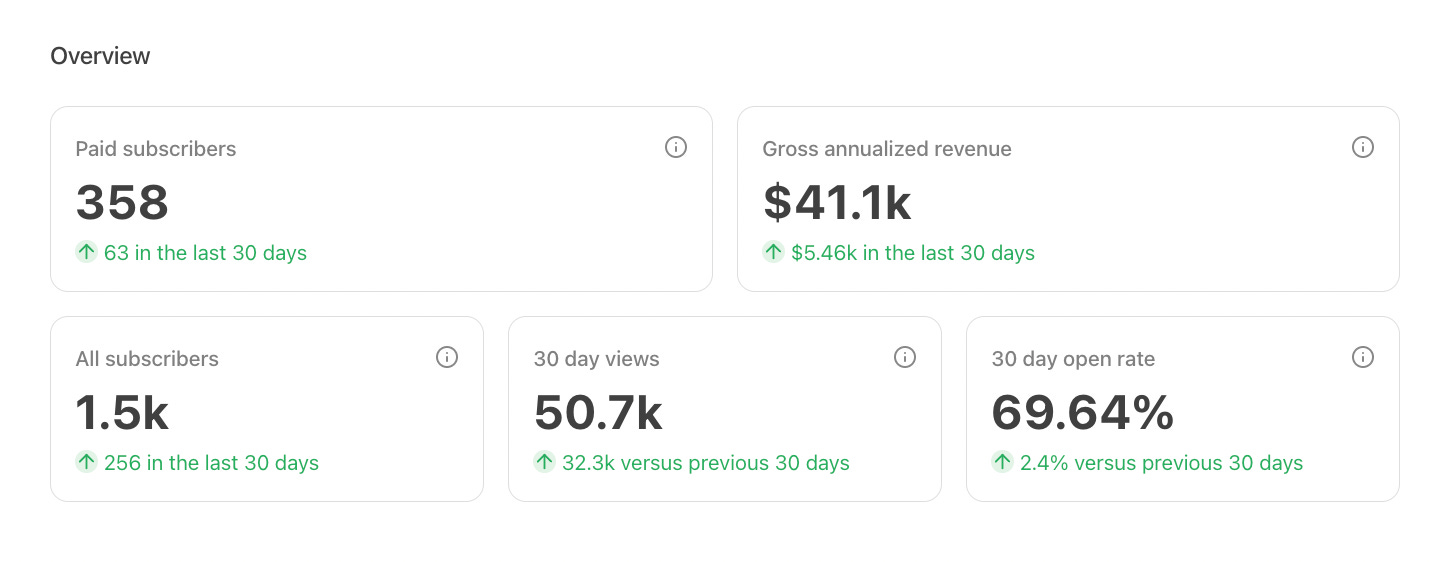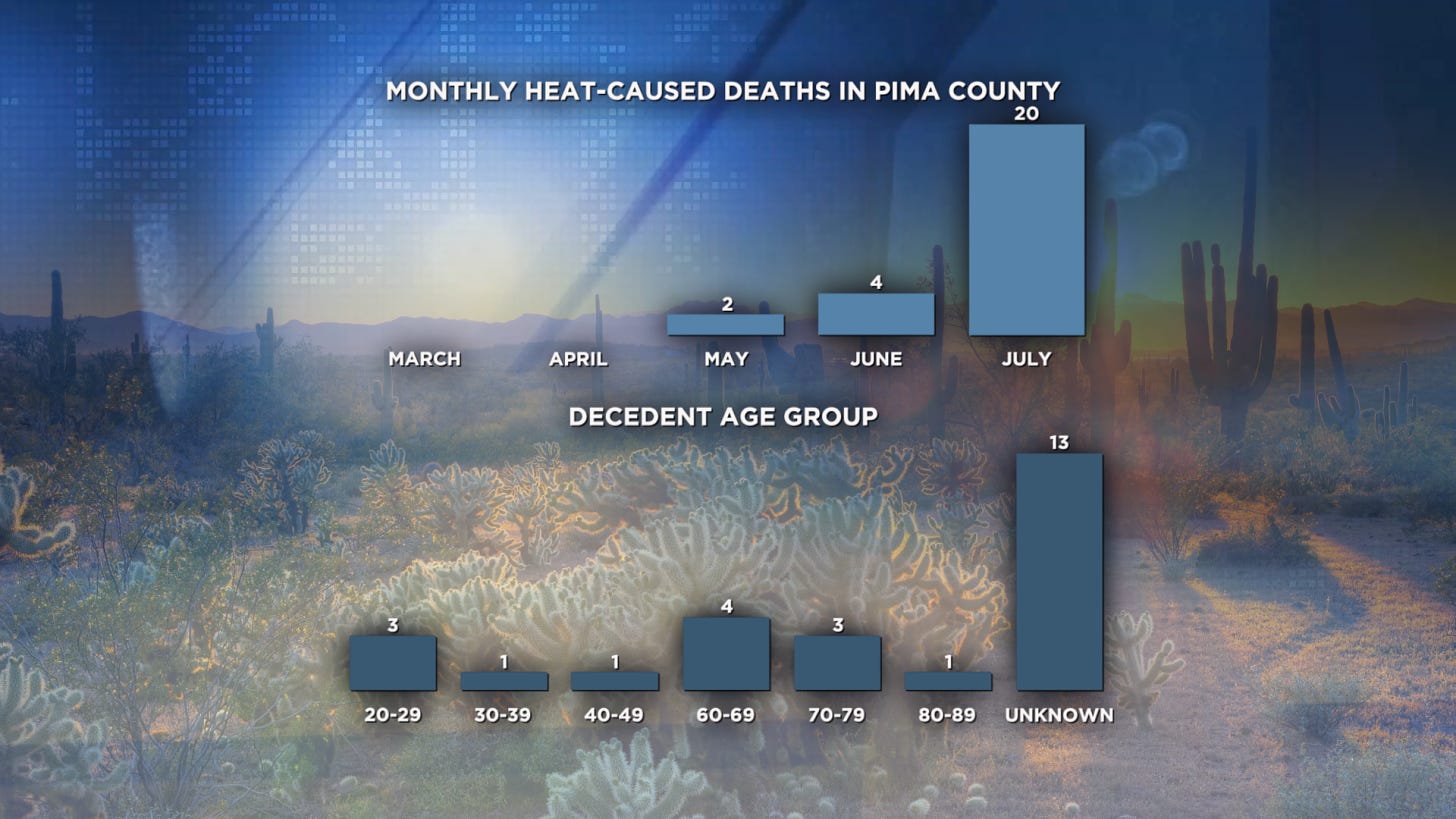The Daily Agenda: Happy anniversary to us!
We're having the time of our lives ... People seem to like what we're doing ... Tucson is breaking all sorts of records this summer.
Today marks one month since we launched the Tucson Agenda on the Fourth of July, and what an amazing month it’s been.
We’ve been having a blast! It’s so much fun that it sometimes doesn’t even feel like work, which is refreshing and such a privilege.
First of all, thank you. We couldn’t do any of this without you. And an extra big thank you to those of you who are choosing to support local journalism by paying for the Tucson Agenda.
We’re journalists, so it should come as no surprise that we’re big believers in transparency. And this feels like a great time to update you on what’s been going on behind-the-scenes, reflect on what we’ve learned, and take a moment to lay out what’s ahead.
Let’s start with some big-picture stuff
You really came through for us. We weren’t sure what to expect when we started the Tucson Agenda, but our paid subscribers have already put us on track for $41,000 in annual revenue.
This has kind of blown our minds. Still, it’s not nearly enough to pay both of us for a year, especially when you factor in the costs of paying Substack, taxes, and all the other expenses that come up.
We have almost 1,500 total subscribers, including nearly 360 who pay for their subscriptions. If all our free subscribers decided to pay for their subscriptions today, we could keep doing this forever. More realistically, we need to grow our total subscriber base by about 4X this year and maintain a strong paid-to-free ratio of subscribers, which we think is possible.
Our biggest hurdle is just letting people know we exist. But you’re our biggest asset on that front. Please take a moment to share the Tucson Agenda with your friends, family, coworkers and frenemies.
Better yet, buy someone a gift subscription!
Either way, if we can convince another 542 people that the Tucson Agenda is worth paying for, we’ll be set for the year as a 100% subscriber-funded publication. Now, wouldn’t that be cool?
Behind the scenes
This is really fun. Here’s what we’re loving the most:
Caitlin: This past month has been incredible and I wake up each day, excited to get to work. About a week after our launch, I realized that this is how I felt when I first became a reporter, before increasing corporate demands, shrinking resources and other factors sucked away a lot of the joy. This is the very best job and it feels great to get back to the basics and return our focus to journalism as a community service.
Curt: The last month has been remarkable in a bunch of ways, but what stands out most to me is that I get to write with my own voice. The writing style for a newsletter is kind of a mix of reporting (which I did for a decade or so) and opinion writing (which I did for about 18 months). Basically, we’re trying to get you the information you need, without boring you to tears. That’s a rare opportunity in the journalism world.
The struggle is real
It takes a lot of hustle to put out a daily newsletter, but we relish the freedom to pursue stories that interest us. There’s a ton of news out there and not nearly enough journalists in Southern Arizona to cover it all. There are days where we feel like kids in a candy store because there are so many good — and important — stories out there for us to pursue.
The other side of this is really hard. We both have experience with audience engagement and some other strategies that come with growing readership, but the business side of this is very new.
It feels weird and uncomfortable to constantly ask for money, but we want to keep doing this, so we’re pushing through. Anyway, click that button!
Designing a newsletter has also been a bit of a learning curve. We think we found a solid structure, but we don’t want to get too attached to it. The Tucson Agenda stole a lot of ideas that worked from our sister newsletter, the Arizona Agenda. But we want to continue to evolve into something more … Tucson. Caitlin is partial to some live events, restaurant and entertainment updates, while Curt would probably start a “Today in City Zoning” feature if he didn’t think it would bore you to death.
But we want to hear from you — what kind of feature would you like to see us take up regularly or semi-regularly?
The successes keep coming
We covered what we said we would cover. When we pitched the idea of the Tucson Agenda, we said we would focus on local government and what we called “government-adjacent” activity. We followed through on that promise. We wrote about the city council elections, campaign finance, local water policies, the city’s bus fleet, craziness at school board meetings, funding for local schools, rezoning, affordable housing, mental health services, and other local topics.
A lot of government officials read what we’re writing. County and city officials and their staff, employees with the Arizona Attorney General’s Office, state lawmakers, members of Congress, and others subscribe. We also have local leaders, changemakers, educators and people who are actively working to better the community. We’re proud to have such an impressive subscriber base, and it’s been cool to see people sign up after we’ve written about them (that’s happened a lot.)
At least two-thirds of our subscribers open the newsletter every day and our 30-day open rate is nearly 70% — that’s huge! We also end up with more views of each newsletter than our number of total subscribers and our normal views are over 2,000 per newsletter. That says to us a lot of you are sharing the newsletter. Which is great!
What we’ve learned
People really are hungry for this type of news. The number of views each of our posts get and the reader engagement, in terms of likes and comments, tells us this. We’re looking for gaps in coverage to make sure you’re getting news from us that you can’t get anywhere else. There will be times that’s not the case (we aren’t going to sit out on an election) but we’re trying to work smarter, not harder, so that you benefit the most from reading our work.
Newsletters are freeing. We aren’t confined by newspaper space, rules, formats, etc., so we can play around with memes, tweets, and other images. We also can have a “take.” But we have to be wary of overstepping. A solid “here’s the deal” is invaluable to readers; a whiny “this is what pisses me off” is about as useful as an irate comment on a Facebook post.
We are not a newspaper and we aren’t going to try to turn into one. We have a newspaper in Tucson and it’s still a really good one. That’s not what you need us for, and we’re gong to continue to deliver a product that you want and need. But we still have found ourselves a few times trying to cover everything or break news before other outlets. Old habits die hard.
A lot of what needs to be reported isn’t rocket science, but reporters need time to do it. That means going through newsletters from city council members, memos from the county administrator, watching public meetings, tracking elected officials’ social media accounts, poring through public data, etc.
What’s ahead
We’re still hungry. We’ve come a long way in one month, but we’ve got a long way to go to become sustainable, so the fundraising work will continue. But we have a thousand other things we’d rather do.
We promised extras, and here they come. Now that we’re up and running and have a good rhythm, we’re ready to paid subscriber deliver the perks we talked about pre-launch. On Monday, our paid subscribers will find a podcast with Jill Jorden Spitz, former editor of the Arizona Daily Star. If you’ve been curious about what Jill is up to these days, you don’t want to miss this. Stay tuned for reader chats (we’ll be polling you for topics) and on August 27, we’re holding a live event at The Loft, with special guest David Fitzsimmons, former editorial cartoonist at the Star turned comrade in the Substack army.
We’ve got ideas. We’ll be reaching out to neighborhood associations to get a pulse on the issues our citizen groups are focusing their attention on, and we’ll be bringing you a local look at the upcoming legislative session. Caitlin has some solutions stories in the works and Curt is setting his sights on the November election.
You can’t escape housekeeping. Just like doing the dishes or vacuuming, some tasks are so easy to push off for another day. We have a lot of little items we need to take care of, such as tweaking our “About” page, that we’ll do in the next week or two.
And we’re pursuing new funding opportunities. We’re starting to establish advertising and partnership options to help bring in some additional revenue. We’ll keep it from becoming a distraction to the reader experience and we’ll keep it local and limited to causes and companies we believe in. If you’re interested in supporting local journalism and generating buzz for your business, nonprofit or group, hit us up! Info@tucsonagenda.com.
Thanks again for reading and supporting our work. We work for you, so reply to any of our newsletters to talk to us.
Help for homebuyers: Pima Tucson Lighthouse, a down payment assistance program funded by the Tucson Industrial Development Authority and Pima Industrial Development Authority, is accepting applications, the Star’s Gabriela Rico reports. The program, which received $25 million in funding from the two groups, allows eligible homebuyers to lock in interest rates of 6.2% on their mortgage and 4% on the down payment assistance, typically around 14%. If the person remains in the home for three years, the down payment assistance is forgiven.
If the development authorities want to throw some of that $25 million our way, that’d be great. Until then, we’re going to have to keep asking for money to keep this operation up and running.
Jazzing things up: Tucson Jazz Festival’s Summer Fest is happening downtown tonight, with Fifth Avenue closed to vehicles from 10th Street to Toole Avenue from 3 p.m. to midnight. Pedestrian and bicycles will have access and area businesses, parking lots and garages will be open. Summer Fest is taking place at Hotel Congress and The Century Room, with doors opening and 6 p.m. and shows starting at 6:30 p.m. The event includes five bands on two stages, and is free for Tucson Jazz Festival members and $10 for non-members. For more information or to purchase tickets, visit tucsonjazzfestival.org
Border busts: Apprehensions and rescues in the Border Patrol’s Tucson Sector have reached record highs, making it the busiest sector in the nation, Arizona Public Media’s Danyelle Khmara reports. Across the nation, Border Patrol has seen a 9% decrease in apprehensions, but the Tucson Sector has seen a 28% increase compared to last year. In July, there were 34,000 apprehensions. Nearly half of the migrants involved have been families.
“We’re at a 20% increase just from last week,” Deputy Chief Justin DeLaTorre said. “For example, just yesterday alone we’re at over 1,900 encounters, and that, I believe, is our second busiest day this year.”
Heed those “excessive heat” warnings: Southern Arizona has seen a rising number of heat-related deaths amidst record-breaking summer temperatures, KVOA’s Lupita Murillo reports. Pima County has had 46 heat-related deaths this year, through the end of July. Pima County Medical Examiner Greg Hess said the death toll has increased since June 14, with 48 days this summer of 100-plus degree temperatures.
Mission critical: Tucson’s Davis-Monthan Air Force Base has been selected by the Air Force to host a new Special Operations Command Wing, which will replace the base’s long-lived A-10 close air-support mission over the next five years, the Arizona Daily Star’s David Wichner reports. The final decision will be made after an environmental analysis process, which includes studies and public comment.
“As our national defense posture evolves to a new region, this next mission ensures that Davis-Monthan — and all of Southern Arizona — continues to be critical to the testing, training, and operational readiness of our military,” said Robert Medler, president of the Southern Arizona Defense Alliance.
Increasing arrivals: Casa Alitas migrant shelter is still seeing between 550 and 600 new arrivals each day, with an increase in families seeking support as opposed to single adults, Ward 1 Councilman Steve Kozachik wrote in his newsletter. Tucson’s shelter of shelters is working with shelters in Phoenix and Las Cruces to provide support, but the amount of transportation needed in July is higher than ever before. In the past, the summer has led to a slowdown in arrivals and transports, Kozachik said, but not this year.
50,700: The total number of views the Tucson Agenda has received since our launch.













I would love to see a deep dive into Sun Tran and the potential economic benefits to the ENTIRE community if rides are fare-free. (For example, if low-wage people can get to their jobs via transit, it helps keep them and their families above water; all student riders should always be free, as studenting is a community development process; etc. ) The darker side of Sun Tran may be the for-profit foreign management, if that's still the case, and how much that skims from us.
Would love to see you get a local solutions beat going again - I saw that mentioned in today’s Agenda and I’m so excited about it!!! Love what you’re both doing - reading The Tucson Agenda is one of my new favorite morning routines!!! ♥️